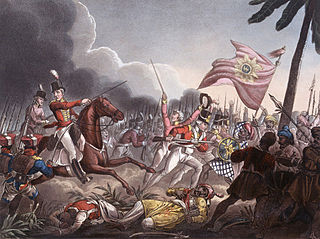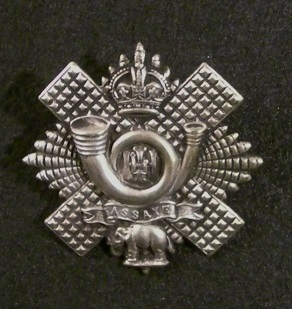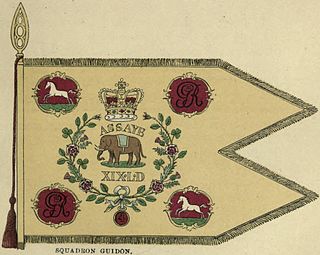
The Battle of Assaye was a major battle of the Second Anglo-Maratha War fought between the Maratha Empire and the British East India Company. It occurred on 23 September 1803 near Assaye in western India. An outnumbered Indian and British force, under the command of Major General Arthur Wellesley, defeated a combined Maratha army of Daulatrao Scindia and the Bhonsle Raja of Berar. The battle was Wellesley's first major victory and the one he later described as his finest accomplishment on the battlefield, even more so than his more famous victories in the Peninsular War, and his defeat of Napoleon Bonaparte at the Battle of Waterloo.
Options for Change was a restructuring of the British Armed Forces in summer 1990 after the end of the Cold War.

The Royal Highland Fusiliers, 2nd Battalion, The Royal Regiment of Scotland is an infantry battalion of the Royal Regiment of Scotland.

The Highland Light Infantry (HLI) was a light infantry regiment of the British Army formed in 1881. It took part in the First and Second World Wars, until it was amalgamated with the Royal Scots Fusiliers in 1959 to form the Royal Highland Fusiliers which later merged with the Royal Scots Borderers, the Black Watch, the Highlanders and the Argyll and Sutherland Highlanders to form the Royal Regiment of Scotland, becoming the 2nd Battalion of the new regiment.

The Royal Inniskilling Fusiliers was an Irish line infantry regiment of the British Army in existence from 1881 until 1968. The regiment was formed in 1881 by the amalgamation of the 27th (Inniskilling) Regiment of Foot and the 108th Regiment of Foot.
The British Army is listed according to an order of precedence for the purposes of parading. This is the order in which the various corps of the army parade, from right to left, with the unit at the extreme right being highest. Under ordinary circumstances, the Household Cavalry parades at the extreme right of the line. Militia and Army Reserve units take precedence after Regular units with the exception of The Honourable Artillery Company and The Royal Monmouthshire Royal Engineers.

The 19th Alberta Dragoons was a cavalry regiment and later an armoured regiment of the Canadian Militia and later the Canadian Army. It was placed on the Supplementary Order of Battle in 1965. In 2006, it was taken off the Supplementary Order of Battle and amalgamated with the South Alberta Light Horse.

The Battle of Ghazni took place in the city of Ghazni in central Afghanistan on Tuesday, July 23, 1839, during the First Anglo-Afghan War.

The 1st Punjab Regiment was an infantry regiment of the British Indian Army from 1922 to 1947. Upon the Partition of India, it was transferred to the newly-raised Pakistan Army. It ceased to exist in this form in 1956, when it was amalgamated with the 14th, 15th and 16th Punjab regiments to form the Punjab Regiment, an existing infantry regiment of the Pakistan Army.

The Bengal Army was the army of the Bengal Presidency, one of the three presidencies of British India within the British Empire.

The Madras Army was the army of the Presidency of Madras, one of the three presidencies of British India within the British Empire.

The 19th Light Dragoons was a cavalry regiment of the British Army created in 1781 for service in British India. The regiment served in India until 1806, and in North America during the War of 1812, and was disbanded in Britain in 1821.

The 62nd Punjabis was an infantry regiment of the British Indian Army. It was raised in 1759 as the 3rd Battalion of Coast Sepoys, and formed part of the Madras Army. It was designated as the 62nd Punjabis in 1903 and became 1st Battalion 1st Punjab Regiment in 1922. In 1947, it was allocated to the Pakistan Army, where it continues to exist as 1st battalion, Punjab Regiment. It is the senior-most surviving infantry battalion of the British Indian Army.

The 84th Punjabis was an infantry regiment of the British Indian Army. It was raised by Captain Donald Macdonald at Vellore on 12 August 1794, as the 34th Battalion of Madras Native Infantry. It was designated as the 84th Punjabis in 1903 and became the 10th (Training) Battalion, 1st Punjab Regiment in 1922. In 1943, it was converted into the 1st Punjab Regimental Centre. In 1947, the 1st Punjab Regiment was allocated to the Pakistan Army. In 1956, the 1st, 14th, 15th and 16th Punjab Regimental Centres where amalgamated to form the Punjab Regimental Centre.











